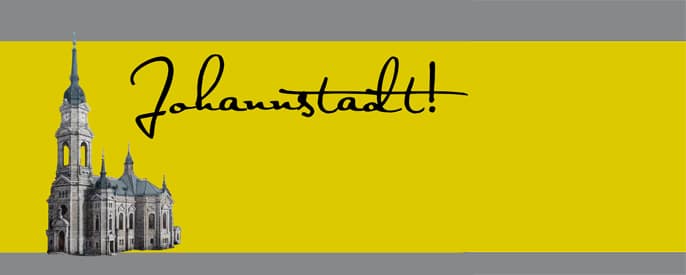Walk from Thomas-Müntzer-Platz down Florian-Geyer-Straße to Pfeifferhannsstraße, then take a quick left before the shopping center onto what was once Blumenstraße. Here you will find location number 7 on the historical walking tour.
Before 1945: Flowers, firepower and factories
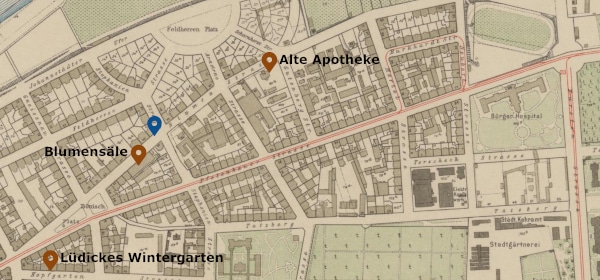
The world before the Ziegelschlag
Blumenstraße follows an old access route which led from the Blasewitzer Tännicht into the city of Dresden. The route—which ran along the outlying estate, “Lämmchen” (near today’s Neubertstraße), as well as the Ziegelschlag (near Eliasfriedhof)—bore the name Jagd- oder Fürstenweg (hunt or prince road), and was also commonly called “Lämmchenweg” (little lamb road). In 1860, it became Blumenstraße (flower street), in homage to the Gärtnerei Lüdicke located here. The “Alte Apotheke Johannstadt” on Blumenstraße is one of the district’s oldest maintained buildings.
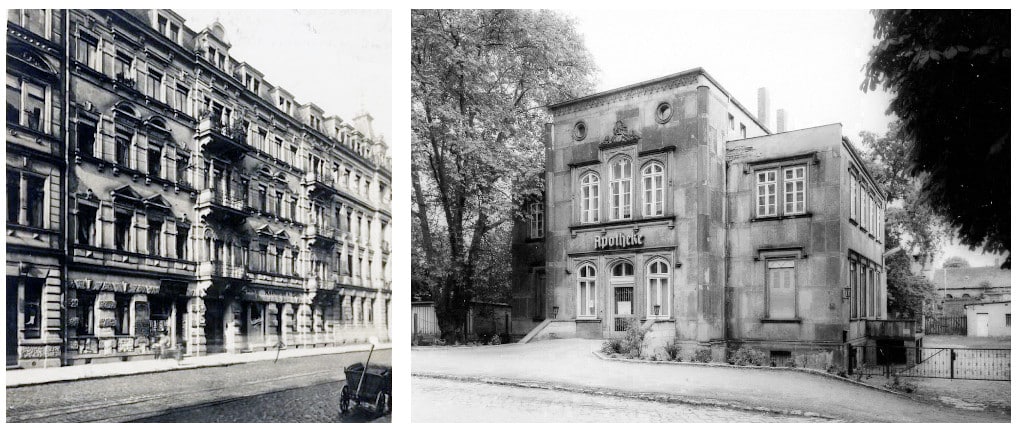
Right: Alte Apotheke on Blumenstraße, 1988. Source: SLUB Dresden / Deutsche Fotothek / L. Stellmacher
Businesses in Johannstadt
Thanks to its proximity to the Elbe and the city’s first horse-drawn tram (direction Blasewitz), Blumenstraße became a major business area until the 1870s.
Selected highlights:
– No. 18: “Macaroni and Noodle Factory Hermann Anschütz” (1855–1920)
– No. 47: “Loschwitzer Hof”, founded at the end of the 19th century by Hugo Fritzsche
– No. 48: “Blumensäle” – dance hall created by August Ernst Binder
– No. 66: “Dresden Curtain and Lace Manufacturers, Inc.” (1884–1918), later “Gläser Karosserie”
– Nos. 68/70: “E. T. Gleitsmann” – chemical colors factory with workers’ villa (Alte Apotheke)
– No. 80: “United Factories Photographic Papers” – since 1948, tool retailer “C. H. Morgenstern & Co. GmbH”
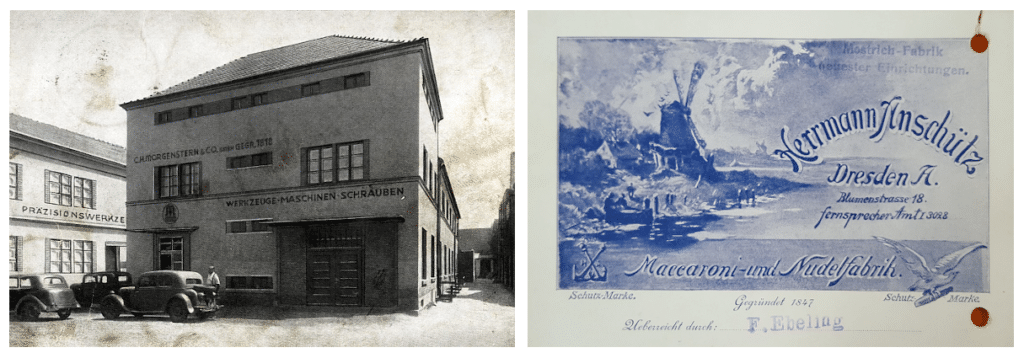
Binder’s “Blumensäle”
The “Blumensäle” (flower halls) at Blumenstraße 48 arose out of a long tradition of public houses at the address. In this house on January 31, 1907, August Bebel spoke for the last time to assembled workers from Dresden. In 1913, the experienced hotelier, August Ernst Binder (1870–1940), acquired the dance halls. He managed them with great success. The publicity for his establishment—“Binder Ernst – und das genügt” (“Binder Ernst – and that’s enough”)—was known throughout the city and gave proof to the pub’s popularity. In the middle of a dance, the music stopped and ten “dance pennies” were collected: a dance band for the whole night cost two marks. The pub consisted of two main halls and various small rooms. After Binder’s death, his wife, Ida Selma, took over the management of the Blumensäle.

After 1945: Destruction, construction and instruction
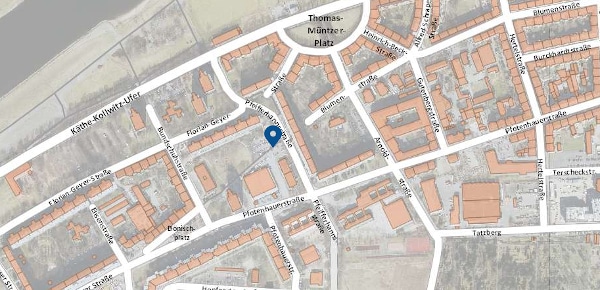
Loss and division
In the night of the bombing on February 13, 1945, all of the buildings on the western section of Blumenstraße, including the “Blumensäle”, were utterly destroyed. In 1973, urban planners decided to split up historic Blumenstraße by constructing apartment blocks on Pfeifferhannsstraße. The western section of Blumenstraße from Güntzplatz to Bönischplatz was renamed Elsasser Straße. Accordingly, the extant eastern segment of Blumenstraße begins with house number 60, confusing visitors unaware of the street’s past.

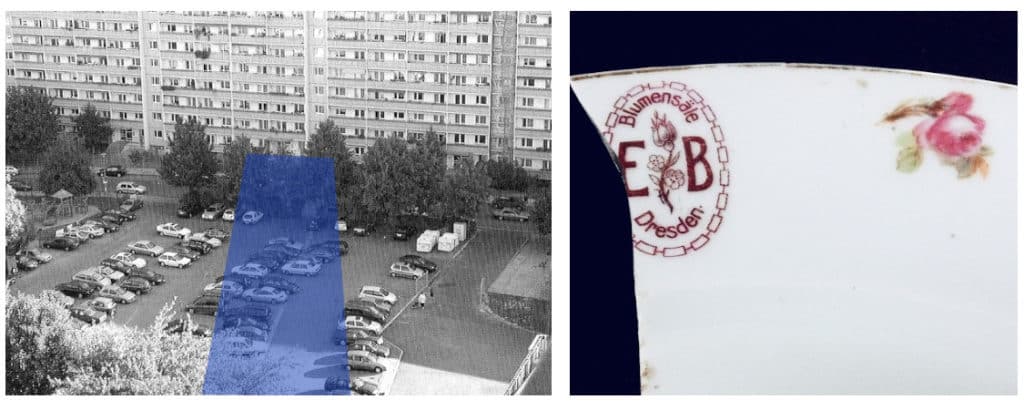
Children’s clinic and polyclinic as “Typenbauten”
In April of 1974, along with the neighboring pre-fab concrete structures, another two buildings opened their gates and are still around to this day: the Kindergarten at Blumenstraße 60 and the polyclinic at Bundschuhstraße 2. Both buildings were planned and erected as so-called “Typenbauten” (standardized structures). This form of project planning allowed for faster and more cost-efficient construction. The buildings could be assembled by following the standard blueprints found in a serial catalog. The building at Blumenstraße 60 is a Typenbau in the “HTP216/12” modular construction style. Since German reunification, the Landeshauptstadt Dresden has run the daycare center, which offers spots for around 160 pre-schoolers and kindergartners. The polyclinic lives on as a medical center.
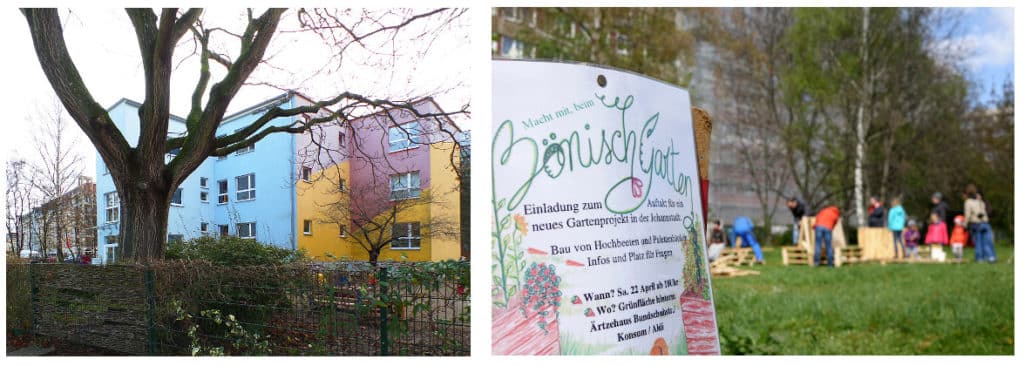
Right: Building raised beds and pallet furniture at “Bönischgarten”, 2017. Photo: A. Schubert
The Stadtteilhaus becomes a cultural magnet
In 2017, the city council decided to establish the Stadtteilhaus Johannstadt, breathing new energy into what was once the stretch of Blumenstraße between Bönischplatz and Pfeifferhannsstraße. Along with the Johannstädter Kulturtreff e. V., , the building houses the Kinderschutzbund’s “Kindertreff JoJo”, the Johannstädter branch of the Ausländerrats Dresden, the Stadtteilverein Johannstadt, as well as numerous other sociocultural offerings in the neighborhood. The redesigned hub of former Blumenstraße connects the Stadtteilhaus with Bönischplatz. A redesign is also in the works for the adjacent green space, “Bönischgarten”, which since 2017, thanks to a citizen-run initiative under the aegis of UFER-Projekte Dresden e. V., has already been home to a small garden, consisting of raised beds and benches made out of Euro pallets.
Text: Matthias Erfurth, Matthias Kunert, Henning Seidler
